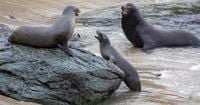On a quiet July evening at Point Pinos Beach in Pacific Grove, California, a simple family outing spiraled into a nationwide controversy that would dominate headlines and spark heated debate about wildlife protection, due process, and the power of social media. What began as an accusation of animal mutilation quickly unraveled into a story brimming with misunderstandings, government action, and the very human tendency to leap to conclusions.
It all started on July 27, 2025, when Jason Bietz, a Hanford resident, took his teenage daughter—an aspiring marine biologist—for a stroll along the coast. As the sun dipped low, the pair came across a dead sea lion washed up on the sand. According to The Los Angeles Times, Bietz and his daughter stopped to inspect the carcass, intrigued by the exposed skull. Unbeknownst to them, their curiosity would soon place them at the center of a federal investigation.
Nearby, Monterey local Rashelle Diaz observed the scene. Suspicious of Bietz’s intentions, she began recording on her phone. In her video, Diaz confronts Bietz about his actions, asking, “What do you need the dead seal for?” Bietz responds, “I told you we’re just taking the head.” When Diaz presses further, he adds, “The skull.” She continues, “To dry it?” and Bietz answers, “Yes.” These brief exchanges, as reported in The Los Angeles Times and corroborated by Diaz, would soon become the crux of a federal manhunt.
Diaz, convinced she had witnessed a crime, contacted authorities. She told local TV outlet KSBW and later The Times that she saw Bietz prodding the sea lion with what she believed was a knife and that he was "decapitating a seal he had already skinned, and separated the skull from the body." Diaz claimed she saw Bietz and his daughter place something in a plastic bag before leaving. While she acknowledged she did not see the actual removal of the head, her account was enough to set off alarm bells at the National Oceanic and Atmospheric Administration (NOAA) Fisheries enforcement division.
On October 1, 2025, more than two months after the initial incident, NOAA Fisheries posted a photo of Bietz online, describing him as a middle-aged white male, about 5 feet 9 inches tall, with a graying beard and camo cargo shorts. The agency offered a $20,000 reward for information leading to an arrest, civil penalty, or criminal conviction related to the alleged decapitation. The alert described a man “using a hunting knife to remove the head of a deceased sea lion,” placing the head in a plastic bag, and leaving in a late-model white Cadillac Escalade.
This was not the first time NOAA had offered such a reward. Earlier in March 2025, a similar incident in Bodega Bay saw a man in his 30s reportedly removing a dead sea lion’s head and fleeing on an e-bike. In both cases, the $20,000 reward underscored the seriousness with which authorities treat violations of the Marine Mammal Protection Act—a law that forbids harming, disturbing, or even collecting parts from marine mammals, alive or dead. Penalties can reach $36,498 in civil fines or up to $100,000 and a year in jail for criminal violations, as detailed by the Alaska Department of Fish and Game and cited by multiple outlets including the Daily Mail.
The public response was swift and, at times, harsh. Bietz soon found his photo circulating widely, labeled as a potential wildlife criminal. Yet, as the days unfolded, the narrative began to shift. Bietz reached out to NOAA investigators to clear his name. He denied ever harming the sea lion, insisting that the skull was already exposed when he and his daughter found the animal. He also denied carrying a knife, suggesting the object in his hand was likely a stick, his phone, or a key lanyard.
To back up his claims, Bietz provided The Los Angeles Times with a photo taken at 3:42 p.m. on July 27—nearly four hours before the confrontation with Diaz. The image showed the sea lion’s skull already clean and attached to the body. “She made accusations that I skinned its skull, and I severed its head and then I took it with me,” Bietz told the Times. “Those statements have been 100% unequivocally refuted.”
Within 24 hours of posting Bietz’s photo, NOAA removed it and issued a statement acknowledging that the man had been located and that, in fact, no marine mammal parts had been removed from the beach. The agency’s about-face was as dramatic as its initial alert. As of early October, further comment from NOAA was unavailable due to a federal government shutdown, leaving some questions lingering in the public mind.
For her part, Diaz admitted her assumptions were incorrect. “I currently know that he did not decapitate it, even though he said that’s what he was doing, so that’s what I had assumed that he did,” she told The Los Angeles Times. Still, Diaz believes her intervention may have prevented Bietz from taking further action: “I caught him, and then he wasn’t able to do what he was planning on doing, which was my goal.” She emphasized that her intent was to protect marine life and raise awareness about the laws, not to trigger a nationwide manhunt. “My main goal was to spread awareness about the laws and protecting our beloved marine mammals here,” Diaz said, “not to have this whole $20,000-reward-if-you-find-him-type thing.”
Bietz, reflecting on the ordeal, suggested that his own flippant remark—“It’s possible I said that I was just going to take the head, as a smart ass, sarcastic remark”—was to blame for the misunderstanding. The episode, he said, had been blown out of proportion by a combination of miscommunication and official overreaction.
This incident also comes amid a broader context of heightened concern about human interactions with California’s sea lions. While the species is not endangered, it is protected under federal law, and recent aggressive encounters—including a 9-year-old girl being bitten at a surf camp and a colony attacking surfers after exposure to toxic algae—have put both people and pinnipeds on edge. The Marine Mammal Protection Act, established to safeguard these animals, has strict rules for a reason, even if they sometimes lead to confusion or overzealous enforcement.
As the dust settles, the story of Jason Bietz, Rashelle Diaz, and the dead sea lion at Point Pinos Beach stands as a cautionary tale about the power of assumptions, the weight of words, and the importance of careful, fact-based investigation when wildlife and human interests collide.




